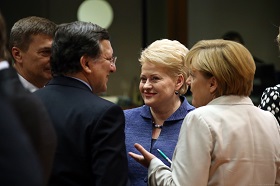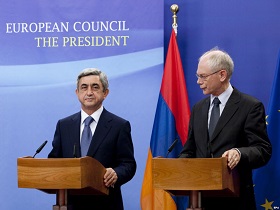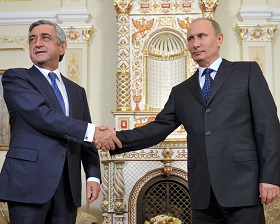The Vilnius Summit: Armenian Dimension
In
Login if you are already registered
(no votes) |
(0 votes) |
PhD in Political Science, Head of the Center for Regional Studies at RAS Institute for the U.S. and Canadian Studies
At the Eastern Partnership Summit in Vilnius on November 28-29, 2013, Armenia chose not to sign the Association Agreement and the accompanying accords on the Deep and Comprehensive Free Trade Area (DCFTA). Meanwhile, a joint statement adopted at the event underlines that "the EU and Armenia have today reconfirmed their commitment to further develop and strengthen their cooperation in all areas of mutual interest within the Eastern Partnership framework."
At the Eastern Partnership Summit in Vilnius on November 28-29, 2013, Armenia chose not to sign the Association Agreement and the accompanying accords on the Deep and Comprehensive Free Trade Area (DCFTA). Meanwhile, a joint statement adopted at the event underlines that "the EU and Armenia have today reconfirmed their commitment to further develop and strengthen their cooperation in all areas of mutual interest within the Eastern Partnership framework." [1]
The Vilnius summit has vividly demonstrated that complementarity is becoming the key feature of Armenian foreign policy, as seen from Yerevan's wavering up to its final pick of the Eurasian vector for its national development strategy.
However, is Armenia's choice actually final or is it subject to change? To what extent does it hinge upon the maturity of elites and society, two populations that are steadily growing apart? What are the upsides and downsides of the Customs Union (CU) for Armenia and what will Moscow gain from Yerevan's participation? Finally, to what extent does the Eastern Partnership serve EU interests and what are its main flaws?
The EU and Armenia: Plans and Reality
Although no basic agreement was signed with Yerevan at the Vilnius summit, Brussels will not ignore Armenia's aspirations for integration, keeping the country within the broader scope of European interests.
The EU seems eager to move ahead with a diversified plan for engagement with Armenia based on the available groundwork
Remarkably, Yerevan’s intention to join the Customs Union and the Eurasian Economic Union process voiced by President Serzh Sargsyan on September 3, 2013 triggered an avalanche of criticism from the European bureaucracy, which accused Armenia of derailing negotiations with the EU and making initialing of the Association Agreement impossible (which was to take place at the Vilnius summit) [2]. As early as September 4, the European Commission stated that the DCFTAs could be compatible with economic cooperation with CIS members [3].
Hence, the EU seems eager to move ahead with a diversified plan for engagement with Armenia based on the available groundwork due to several factors:
First, the still universally felt global financial crisis, combined with U.S. overstrain, offer little hope for a perceptible improvement in the prospects, at least in the mid-term, for inevitably reducing the scope of the Eastern Partnership. Besides, with very unpredictable situations in the Middle East and Afghanistan, policies in the Caucasus will become increasingly important for the West, which has actually reduced their inflated expectations about the Eastern Partnership, as clearly demonstrated by the example of Armenia.
Second, the adoption of the Eastern Partnership program has drastically changed Europe. The EU is obviously on the verge of significant changes that require a review of current integration principles. The absence of a final aim in the Eastern Partnership venture makes the EU vulnerable, pushing it to make compromises on its Eastern policy. While its Eastern partners often fail to behave according to such European values as democracy, human rights, etc. (Brussels is well aware of this fact), the EU should welcome cooperation with the Easterners on any level.
This point appears especially important for the European Union in view of President Obama's intentions to place the U.S.A. at the lead of the Transpacific and Transatlantic partnerships, two mammoth economic coalitions [4].
Third, Brussels needs instruments for allowing the Eastern countries to coexist in the EU area in the absence of Free Trade Agreements (FTA), while simultaneously advancing and deepening other cooperation formats in the areas of common foreign and security policy, justice and internal affairs.
The Eastern Partnership appears to suffer from a significant defect, since the EU has been unable to outline the final goal of its policy in the region. Brussels has offered an assortment of initiatives, but has never had a genuine strategy. Targeted countries have never been offered EU membership, the key lure. If Brussels is serious about a neighborhood policy aimed at stability, security and prosperity, it will have to stick to its previous approaches to these states.
The absence of a final aim in the Eastern Partnership venture makes the EU vulnerable, pushing it to make compromises on its Eastern policy.
The EU cannot afford to discard Armenia because of the high level of inconsistency shown by its Eastern partners toward integration processes: "The EU should not give up Armenia because in the near future it may change its mind and move toward the EU." [5] Nevertheless, Brussels insists on respecting the sovereign choice of countries striving for the EU integration." [6]
In addition to the basic errors within the Eastern Partnership, Brussels appears ready to recognize its mistakes along the Armenian track. First of all, this relates to the inability of the EU to provide Yerevan with security guarantees, which has played a large role in determining Armenia's decision to join the Customs Union. In addition, some EU lawmakers believe that Brussels has been invariably indifferent toward Yerevan, and, more so, there are also many supporters of Azerbaijan and Turkey. The European Union has long regarded Armenia as a problematic country, which brings more harm than good in terms of realpolitik, in contrast to the oil-rich Azerbaijan.
Today, Brussels appears to be fully aware that the guarantees it offers to Yerevan are beyond criticism, while the system of mutual obligations for integration with the EU should primarily account for the interests of both parties and become more comprehensive.
Either way, the signing of any serious document with Yerevan cannot but envisage special terms for Armenia's participation in the European Union, although the latter has never dealt with the Karabakh conflict. There is an understanding that talks on the EU partnership could be linked to the attempted revival of the Karabakh negotiations, since an Association Agreement is inter alia based on the inadmissibility of closed borders. To this end, note that at the summit of the European People's Party in Chisinau, Mr. Sargsyan stated that "trading with the European Union cannot be effective under the remaining blockade of Armenian borders by Azerbaijan and Turkey." Consequently, the Karabakh settlement and the opening of the Armenia-Turkey border could be linked to signing the agreement, which may later allow Brussels to outline a more distinct timeline for Armenia signing a framework agreement with Azerbaijan.
To a certain extent, this could be an attempt to resolve the conflict through the European Union.
The inability of the EU to provide Yerevan with security guarantees has played a large role in determining Armenia's decision to join the Customs Union.
European strategists see one more mechanism capable of escalating the policies of Brussels towards opening the EU market to goods and services from Eastern countries and providing them with energy supplies that bypass Russia if Russia chooses to ban imports. Moscow is also seen as more vulnerable due to the discovery of shale gas and higher energy efficiency. In addition, Russia has joined the World Trade Organization, which means both extra privileges and obligations. However, all these are only plans, while action seems somewhat distant.
In its turn, Armenian leaders continue to state that they want "deeper cooperation and extended relations with the EU which should not contradict its participation in the Customs Union." [8] That might direct Armenia's integration along two tracks, i.e. toward the EU in the absence of a free trade agreement, and toward the CU.
After September 3, 2013, the European Parliament ratified the EU-Armenia agreement on visa facilitation and readmission. But the discussion of political issues and future economic relations between the EU and Armenia has been postponed due to Yerevan's new international obligations under the Armenia-EU Declaration adopted in Vilnius [9].
At the Vilnius summit, the sides agreed to update the EU-Armenia action plan under the Eastern Partnership program and continue cooperation within the current framework.
Hence, despite certain weaknesses in the Eastern Partnership and taking into account complementarity in Armenia's foreign policy, Yerevan and Brussels seem eager to move ahead with the existing integration process in absence of mutual obligations, i.e. within a simplified and still formal scenario.
Armenia and the Customs Union: a Forced Maneuver or Conscious Choice?
Armenia's official stance on joining the CU was voiced by Mr. Sargsyan in Moscow on September 3, when he met President Putin [10].
Joining the Customs Union, Yerevan was primarily guided by security considerations. The guarantor of Armenian territorial integrity, Russia is bound by the CSTO agreement and by the deployment of its military base in Gyumri. Moscow also co-chairs the OSCE Minsk Group on the Karabakh settlement, while the EU has always shown restraint along these lines, circumventing such critical matters as Karabakh (leaving it to the Minsk Group), the normalization of Armenian-Turkish relations, and opening borders. Opening the border would break Armenia's regional isolation and make it into a transit state with access to Europe. Understandably, Brussels has no levers for handling this problem.
One more driver for Armenia to join the CU has been Turkey's participation in the Syria intervention. Due to Karabakh and the absence of diplomatic relations with Ankara, Turkey's involvement in Syria may cause unpredictable consequences for Armenia.
Yerevan has also been enticed into joining the CU by Moscow's steps to unblock the Abkhaz railway, a matter of paramount importance for Armenia, which is shut out on two sides.
Joining the Customs Union, Yerevan was primarily guided by security considerations.
Entering the Customs Union, Armenia also realizes that its geographical isolation considerably diminishes its attractiveness for promising integration projects, because in contrast to Georgia the country cannot boast a favorable geopolitical position. Not of minor importance are the numerous bonuses promised by Russia in exchange for joining the CU, among them 15 billion rubles for the modernization of Armenian railways governed by Russian Railways under a concession agreement. Rosneft also pledges to invest in the Armenian chemical plant Nairit, and Rosatom has expressed an intention to expand the operations of the Armenian nuclear power station [11]. These steps are designed to minimize growing tensions in Yerevan caused by military-technical cooperation between Russia and Azerbaijan, higher gas prices for Armenia, and Gazprom's plans to increase its share in ArmRosGazprom. At the same time, these promises are so far empty, providing Euro-Atlantic proponents with ammunition in their appeals to Yerevan to remain clear-headed about Moscow's inroads [12].
However, Yerevan's main fear about Eurointegration concerns the scenario where the EU builds a partnership with Armenia, while the Karabakh conflict remains unsettled. This development means that Brussels could force Armenia into imposing a customs regime along its border with the Nagorno-Karabakh Republic.
Armenian leaders insist that no steps will be made to contradict their national interests and cause resentment within society. However, transparency has not been an overwhelming feature of negotiations, both over the Eastern Partnership and the Customs Union. The Armenian political establishment was left in the dark about the contents of these documents, which could imply that such decisions lie solely in the hands of the Armenian president [13].
Armenian elites and experts have entered the public debate about a nationwide referendum over entering the Customs Union, which might be the only platform for an expression of the popular will.
In addition, considerable suspicion arises after some Armenian leaders have turned from frenzied Eurointegration proponents and fierce opponents of the Customs Union (viewed as being "aimed at destroying Armenian sovereignty" into convinced Russophiles supporting the CU project.
However, Armenia's choice in favor of the Customs Union seems fairly conscious and dominated by security considerations, as currently Russia is Armenia's only security guarantor, and with no alternative in the works.
At a joint press conference with Belorussian Foreign Minister Vladimir Makei on November 19 in Moscow, Sergey Lavrov said that "Moscow's approach implies that signing or not signing appropriate documents with the EU is a sovereign choice of any Eastern Partnership state." [14]
No doubt, Yerevan's decision has been sovereign and conscious. It is another matter that the choice was historically predestined by the well-known and still effective legacy of the Soviet commonwealth. This legacy helps explain inability of the Armenian elite to adopt European standards, its reluctance to tighten belts today for the European dream tomorrow, the absence of political will, and the underdeveloped political identity in society. At the same time, due to its geographic location, Armenia will always have to rely on complementary politics in order to maintain balance between the ambitions of Moscow and the interests of the West.
Interests of Russia and Armenia: National Interests or Opportunism?
Armenia is Russia's outpost in Transcaucasia, the most troublesome region for Moscow. Despite its modest territory and economic role within the CIS, Armenia is the only Transcaucasian country, except for the partially recognized Abkhazia and South Ossetia, to host Russian troops. In view of the situation in the Middle East and the closure of the Gabala radar facility in Azerbaijan, this fact is of utmost significance for Moscow. Russian border guards also participate in protecting Armenia’s borders with Turkey and Iran, while Moscow and Yerevan have agreed to extend the deployment of the 102nd Military Base in Gyumri until 2044 [15].
In the near future, Russia will engage Armenia in the creation of a common air defense system [16]. Armenia is a CSTO member, which provides it with weapons and equipment at preferential prices.
Armenia's accession to the Customs Union will trigger the establishment of a new economic zone adjacent to Iran that would be able to participate in laying transit corridors between the Persian Gulf, Russia and Transcaucasia. Of great help in this process is the future Armenia-Iran railway project to be carried out with Russia's participation.
As far as energy is concerned, Russia takes part in such major projects as extending the operations of the Armenian nuclear power plant until 2026, the construction of the Iran-Armenia gas pipeline with Gazprom, and the upgrading of the Sevan-Razdan hydropower station cascade with the help of Inter RAO UES. This last project is intended to increase Armenian electricity exports.
Russia is Armenia's key trading partner, its direct investments in the country exceeding USD 2.4 billion, i.e. almost 45 percent of total FDIs, and its capital invested in over a quarter of the republic's businesses [17].
The above is written only to indicate that Russian interests in Armenia are of national importance and not determined by purely geopolitical ambitions.
In recent years, Russia has worked to set up the Eurasian Union in order to somewhat counterbalance the EU and Eurointegration, aiming to have two centers of political and economic influence in the region. This logic holds that the future of the Customs Union is a vital issue for Russia, which might use this emerging instrument to reinstate its leadership in the post-Soviet space. This is why Moscow did not hesitate to engage Armenia in the Customs Union despite the absence of a common border between Armenia and CU countries, a seemingly substantial barrier.
At the same time, CU membership implies numerous amendments to the economic and customs law of the ascending country. And it is not yet clear what kind of advantages Armenia could obtain in the fuel and energy sector, as well as to benefits for economic development. In addition, the consequences for the communications sector, advantages for the Armenian business, and practical gains from the FTA in the absence of a common border with the CU member states are all not clear.
To a certain extent, the Customs Union (as well as the Eurasian Union in a broader sense) and the European Union mirror each other, both plagued by many unresolved technical problems. At the same time, the positions of Moscow and Brussels are certainly similar. Mr. Lavrov says there is every reason "to conjugate the processes of European and Eurasian integration that should not rest on the EU's unilateral approaches but rather on mutually acceptable areas of cooperation." [18] For its part, the European Union believes that "the DCFTAs could be adjusted for economic cooperation with CIS countries." [19] Provided both sides are willing to hear each other out, this could offer a sound foundation for adopting common rules in a globalizing world.
1. http://www.georgiatimes.info/news/97255.html
2. http://www.panarmenian.net/rus/news/171163/
3. http://newsarmenia.ru/politics/20130905/42931079.html
4. State of the Union 2013: President Obama’s Address to Congress. February 13, 2013
5. http://www.iarex.ru/articles/42254.html
6. http://kommersant.ru/doc/2277328
7. http://www.regnum.ru/news/fd-abroad/armenia/1685623.html
8. http://newsarmenia.ru/politics/20130910/42934559.html
9. http://www.aysor.am/ru/news/2013/11/29/armenia-eu-join-statement/
10. http://voskanapat.info/?p=3311
11. http://www.fundshub.ru/investment/investments/15998.php
12. http://www.iarex.ru/articles/42254.html
13.http://www.yerkramas.org/2013/09/23/armyanskaya-vlast-oppoziciya-i-tamozhennyj-soyuz/
14. http://www.mid.ru/brp_4.nsf/0/CA1F3938EF94672A44257C280051AEB7
15. http://tden.develop.life.ru/articles/show/2953
16. http://ria.ru/defense_safety/20131119/978064313
17. http://comment-respublika.info/comment/showtopic/26239/
18. http://www.mid.ru/brp_4.nsf/0/CA1F3938EF94672A44257C280051AEB7
(no votes) |
(0 votes) |







